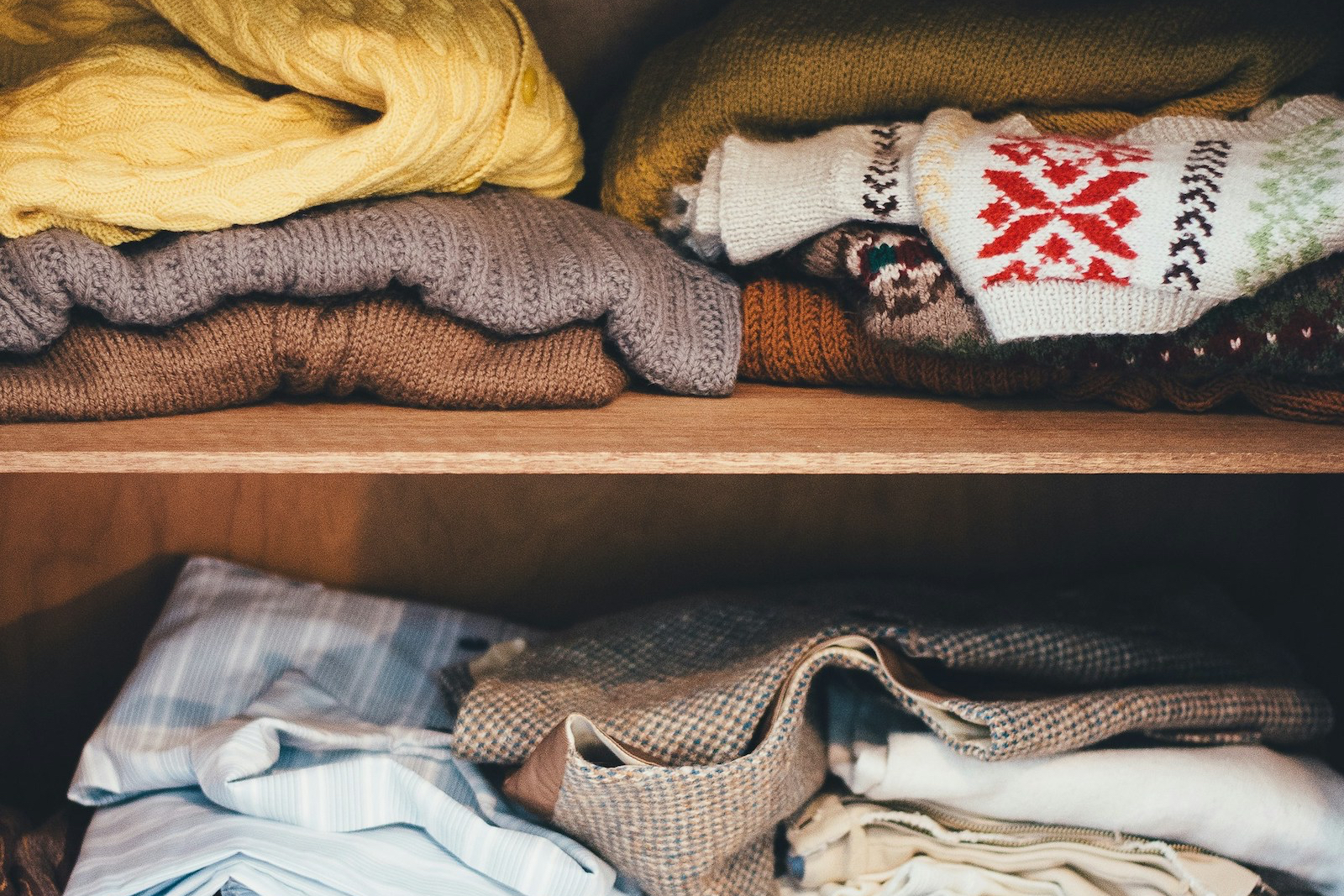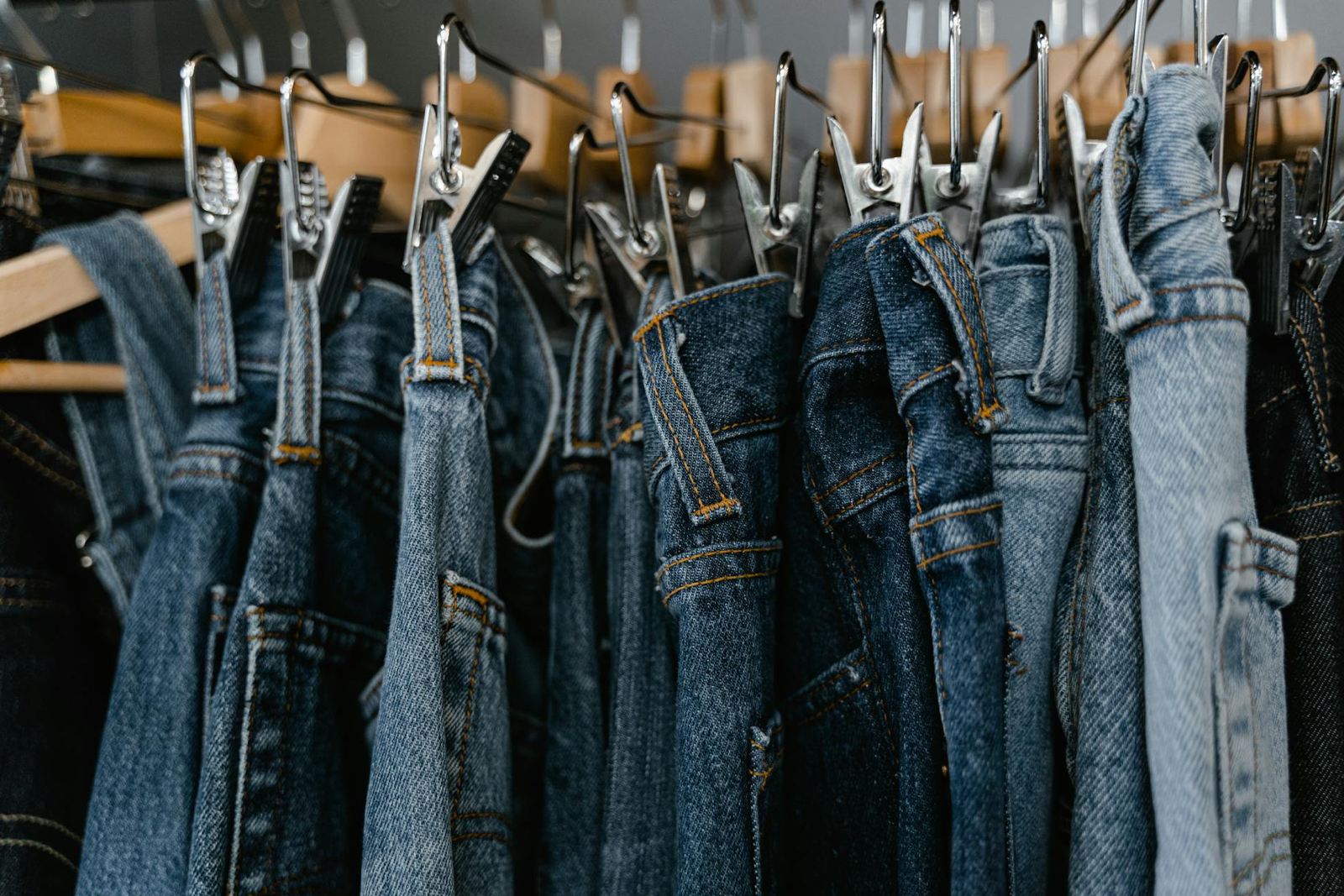RETHINK
A critical view into your wardrobe
1.
Short introduction
2.
A deeper dive into
RETHINK
3.
Quick Wins & Challenges
4.
Now you come into play!
1.
Short introduction
On the way to a sustainable wardrobe with RETHINK.
Find out how you can strengthen your personal style by checking and organizing your closet, and support the change in the textile industry through sustainable consumption.
WHEN SHOULD WE RETHINK?
This solution is suitable for your entire closet: whether your clothing is in good condition, with visible signs of wear or unused and forgotten in the back corner of your wardrobe. Would you like to take a critical look at your closet and style yourself more sustainably? Then discover the solution of RETHINK.

2.
A deeper dive into
RETHINK
When analyzing the data from our GUIDE, we were surprised to discover that over 40% of A-Gain Guide users discarded their clothing simply because they no longer like them. Currently, over 80% of these discarded clothes are disposed of as waste (1). By extending the lifespan of our clothing, we preserve valuable resources and protect the environment. A circular approach to textiles offers the opportunity to make better and longer use of the textiles that we already own.
In our deep dive, we explain the technique of RETHINK and provide a bit of background information on the associated social, ecological, economic and political aspects. Would you like to start "rethinking" your closet right away? Then jump straight to our tips.
TECHNIQUES
To RETHINK your approach to clothing, the first step is to take a wardrobe inventory to get a full overview of the clothes you already have. Take your time and look at your favorites. Which colors, shapes, cuts and materials make you feel comfortable? These pieces reflect your clothing needs and your style, regardless of trends. Did you know that, according to the capsule wardrobe principle, around 37 items in your wardrobe are enough to be dressed appropriately for all occasions? Gather your favorites together and see how you can combine them. A stylist can help you build up a reduced wardrobe and strengthen your own style, as can inspiring role models or video tutorials such as those you will find in our downloadable Resource E-Book.
Put the clothes that are among your favorites, but are broken or no longer fit properly, in a pile. To bring them back to life, you can repair them yourself or seek help from a local tailor. The blouse fits perfectly, but the color was a mistake? Re-dyeing clothes is quick and easy, even in your own washing machine. Don't be afraid to make small changes that will extend and lovingly intensify your time with your clothes! If you are unsure, you can always seek expert help.
The dress from your last summer vacation is fine, but never leaves the wardrobe? Then a new owner will be delighted! There are many ways to keep your clothes in circulation: swap, donate, upcycle, sell or, as a last solution, recycle.
If you cannot decide whether or not you want to keep certain pieces of clothing, put them aside and allow yourself a period of reflection. After this you can then make a decision on what is the right thing to do with these items.
Pauses and moments of reflection, such as this, will also help you avoid impulse buys and clarify whether a new purchase is necessary, and complements your existing wardrobe. If these criteria are met, a new item should ideally only be added if you have first responsibly removed another item. This will keep the number of clothes in your wardrobe constant.
A sustainable closet means buying fewer clothes, wearing them for longer, taking good care of them and passing them on when we no longer need them.

FACTS
In Germany, an average of 60 items of clothing are purchased per capita each year.
ENVIRONMENTAL
A confident awareness of your own style helps to reduce new purchases and keeps you enjoying your clothes for longer. This is the key to a sustainable wardrobe. Large amounts of energy, water and resources are consumed during the production of clothing. By using clothes for a short time and discarding them too quickly, many valuable resources are wasted and mountains of waste are produced. According to McKinsey, every European produces an average of 15 kg of textile waste per year.(3) In particular, fast fashion products made from synthetic materials end up polluting the environment as plastic waste. This plastic textile waste is usually incinerated or ends up in landfill sites of countries in the Global South. According to the UNEP, the negative impact on the climate could be halved if every item of clothing was used twice as often as it is currently being used. (4)
SOCIAL
The change towards a sustainable approach to textiles is a social task and starts with us consumers and the clothes in our wardrobe: after all, the most sustainable clothes are the ones we already own. Have you ever thought about how your appreciation of new purchases differs from your appreciation of older clothes in your wardrobe? Buying fewer new clothes and instead cultivating a more intensive relationship with our clothes represents a radical change in our consumption patterns, especially as fashion is how we express our identity, emotions and creativity.
Due to complex global value chains, we also do not have an intense or appreciative relationship with the people who make our clothes, usually under undignified conditions and in violation of human rights. With the #Whomademayclothes campaign, the Fashion Revolution initiative is drawing attention to this gap and encouraging people to critically question their own consumption and its effects. (5)
FACTS
Clothing is one of the two product groups with the highest risk of modern slavery in the supply chain.
ECONOMY
But above all, the fashion industry itself needs to rethink its way of doing business, which is based on relentless growth and high-volume sales. Fast-moving trends, low quality and new items - which are much cheaper than clothing repair and maintenance costs - are methods used by the industry to cause products to age prematurely (= obsolescence) and encourage us to buy new items again and again. A Greenpeace study from 2019 clearly shows the massive loss of quality after the first wash of supposed bargains, and proves: "If you buy cheap, you buy twice"(7). In the end, fast fashion leads to a more frequent, and therefore likely higher level of spending.
The “cost per wear” formula shows you the cost of your clothes per wear by dividing the price of the garment by the number of days you wear it. While the cost per wear of a pair of €40 jeans worn once a week for a year is €0.77, the cost per wear of a pair of high-quality €120 jeans worn once a week for 5 years is only €0.46. Investing in quality is cheaper in the long term and reduces the negative environmental impact of your clothing consumption.

FACTS
Production wages account for a maximum of 15% of the price of an item of clothing. Doubling these wages would mean an increase of 25 - 75 cents on a single shirt - a price difference that would hardly be noticeable.
POLITICS
Despite growing awareness in the fashion industry, the industry is not changing fast enough and is sticking to the harmful system of "take, make, dispose". A legal framework is therefore needed to put the textile industry on the path to sustainable development. With the Sustainable and Circular Textiles Strategy as a building block of the Green Deal, the European Union is aiming to transform the textile industry into a sustainable ecosystem by 2030.(9)
The strategy includes the introduction of various new directives and regulations to ensure the durability, reparability and recyclability of textiles and to preserve social rights and ecosystems. As this new legal framework is shaped by representatives of the EU member states, the impact of the political regulations can change with every election.
By rethinking your closet, you are taking the first step towards shaping change politically. As consumers, we can increase the pressure on companies and politicians to act. We have the power to help shape change: with sustainable consumption decisions and standing up for our values and a sustainable society with our political voice.
3.
Quick Wins & Challenges
CHALLENGES
- A capsule wardrobe is an exciting, but perhaps daunting challenge, especially if it contrasts to your existing consumption habits. Don't be too hard on yourself, and set yourself new goals at regular intervals to organize your wardrobe piece by piece.
- A personal stylist may seem expensive, but this investment is worth it, if it helps you to understand your own style better, thereby reducing misjudged or impulse purchases in the long term.
- Does a capsule wardrobe seem unnerving or boring to you? You can add variety to your closet, without spending any money, by attending clothes swap parties. Alternatively, you can rent fashion for special occasions.
QUICK WINS
- Conscious consumption and wardrobe organization saves time and money.
- An organized and well-arranged closet saves stress in the morning.
- Your clothes will last longer if they are well organized and stored.
- Once you have discovered your personal style, you will feel more comfortable, more confident, and be able to make clear purchasing decisions.
- You reduce your personal ecological footprint.
4.
Now you come into play!
1. Try out our DIY tips
To help you take your first steps towards a more sustainable wardrobe, we have put together an e-book resource guide with lots of helpful tips on how to RETHINK.

2. Find a local service
MAP & GUIDE
An appointment with a stylist can offer you personal support. You can use our MAP and our GUIDE to find services in your area that offer sustainable "wardrobe styling". They can not only support you with your styling, but often also offer inspiration for upcycling clothes.
Clothing is emotional and personal. Every solution is unique. Therefore, always reflect on whether the options that a stylist has offered you, meet your needs and fit into your everyday life.

